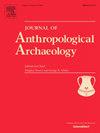地中海和阿尔卑斯山之间的十字路口:里帕罗邦布里尼奥里尼亚纪的石器技术、原材料采购和流动性
IF 2.2
1区 社会学
Q1 ANTHROPOLOGY
引用次数: 0
摘要
Riparo Bombrini是Balzi Rossi遗址综合体内的一个崩塌的岩石掩体,位于滨海阿尔卑斯山脉、亚平宁山脉北部和利古里亚海的交汇处。在旧石器时代,这一独特的环境是人类沿着liguro - provenalal弧流动的重要生物地理走廊。Bombrini的多学科研究确定了三个考古层(即A2, A1和A0)覆盖在半无菌的Mousterian水平上。本文通过分析A2和A1层的岩屑组合,以及先前描述的A0层的早奥震旦系组合,探讨了原奥震旦系的内部变异性。对组合完整性、岩屑技术和原材料采购的分析揭示了不同的流动性和土地利用策略,尽管技术统一。值得注意的是,在原奥日震期和早奥日震期地层中,岩石的生产和使用经常涉及来自距离超过150公里的外源物质,有些甚至达到450公里,从Rhône山谷到亚平宁山脉中部。废弃岩石的采购距离的变化及其减少强度的变化突出了后勤和住宅流动的不同模式。与区域遗址的比较分析表明,采集者拥有复杂的领土知识,挑战了传统的观点,即原aurignacian是拓荒者进入陌生景观的结果。本文章由计算机程序翻译,如有差异,请以英文原文为准。
A crossroads between the Mediterranean and the Alps: Lithic technology, raw material procurement, and mobility in the Aurignacian of Riparo Bombrini
Riparo Bombrini is a collapsed rockshelter within the Balzi Rossi site complex, located at the intersection of the Maritime Alps, Northern Apennines, and Ligurian Sea. This unique environmental setting served as a crucial biogeographical corridor for human mobility along the Liguro-Provençal Arc during the Paleolithic. Multidisciplinary research at Bombrini identified three archaeological layers (i.e., A2, A1, and A0) overlying a semi-sterile Mousterian level. This paper explores the internal variability of the Protoaurignacian by analyzing lithic assemblages from layers A2 and A1, as well as a previously undescribed Early Aurignacian assemblage from layer A0. An analysis of assemblage integrity, lithic technology, and raw material procurement reveals distinct mobility and land-use strategies, despite technological uniformity. Remarkably, lithic production and use in both Protoaurignacian and Early Aurignacian layers frequently involved exogenous materials sourced from distances exceeding 150 km, with some reaching up to 450 km, spanning from the Rhône Valley to the Central Apennines. Variability in the procurement distance of discarded lithics and their changing reduction intensities highlight distinct patterns of logistical and residential mobility. Comparative analysis with regional sites indicates that foragers possessed sophisticated territorial knowledge, challenging the traditional view of the Protoaurignacian as the outcome of pioneering groups entering unfamiliar landscapes.
求助全文
通过发布文献求助,成功后即可免费获取论文全文。
去求助
来源期刊

Journal of Anthropological Archaeology
Multiple-
CiteScore
4.00
自引率
11.10%
发文量
64
期刊介绍:
An innovative, international publication, the Journal of Anthropological Archaeology is devoted to the development of theory and, in a broad sense, methodology for the systematic and rigorous understanding of the organization, operation, and evolution of human societies. The discipline served by the journal is characterized by its goals and approach, not by geographical or temporal bounds. The data utilized or treated range from the earliest archaeological evidence for the emergence of human culture to historically documented societies and the contemporary observations of the ethnographer, ethnoarchaeologist, sociologist, or geographer. These subjects appear in the journal as examples of cultural organization, operation, and evolution, not as specific historical phenomena.
 求助内容:
求助内容: 应助结果提醒方式:
应助结果提醒方式:


